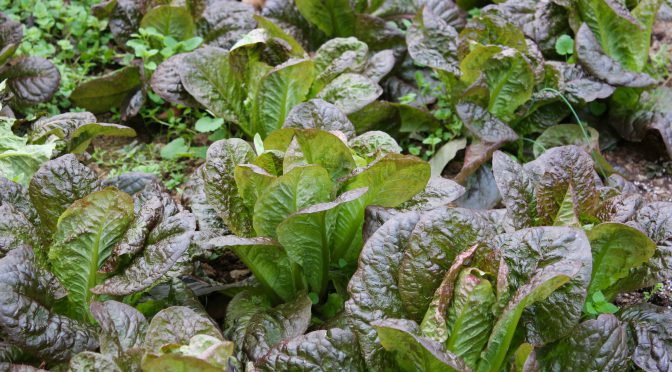One of my favorite things about fall is that the cool weather provides a second opportunity to grow lettuces. There are so many varieties to bring color, beauty, and flavor to your autumn garden and plate. Here are some tips for starting your own fall lettuce garden.
Varieties
Here are a few of our favorite varieties for fall plantings though many others will do well too.
- Outredgeous Romaine Lettuce
- Rouge d’Hiver (Red Winter) Romaine Lettuce
- Sweet Valentine Romaine Lettuce
- Winter Density Buttercos Lettuce
- Red Salad Bowl Looseleaf Lettuce
- Salad Bowl Looseleaf Lettuce
- Anuene Batavian/ Crisphead Lettuce
- Crawford Bibb (Butterhead) Lettuce
- Schweitzer’s Mescher Bibb Bibb (Butterhead) Lettuce
Sowing
Lettuce germinates best when soil temperatures are 75°F or lower and thrives in cool weather when temperatures are in the 60°s. In areas where temperatures are still high during the early fall you may need to a few tricks to get lettuce growing well.
Waiting longer to plant isn’t always a great option because as the weather cools we lose daylight. Lettuce and other plants will take longer to mature during the fall as the light dwindles.
One way to help provide your lettuce with cool temperatures is to mist the soil regularly, at least once a day. This helps keep it moist and cool, especially important while its germinating. You can also use a thin row cover or material like tulle to shade the soil a bit.
Alternatively, you can sow lettuce in trays in a cool room and transplant them later. Romaine, crisphead, and butterhead lettuces work well for this.
Lettuce can be sowed in rows or gently broadcasted. Generally, broadcasting works better for looseleaf and cut and come again lettuce mixes that will be harvested small. Broadcasting over the entire bed for these types of plantings can help block out weeds. If you want full heads of lettuce it’s typically easier to plant in rows so you can easily weed and ensure they have enough space to mature.

Thinning
No one likes thinning but it’s critical for healthy plants. As previously mentioned, looseleaf lettuces are better suited to tighter plantings however, it’s still best if they have some air circulation. Larger, heading lettuces need more space and should be thinned to 10-16 inches depending on the variety. If you wait to thin until plants are 1-2 inches tall, they make excellent baby salad greens.
Season Extension
There are a number of ways to keep your lettuce garden alive later into fall and even winter. Cold-frames and low tunnels are affordable, simple to set up options. Even tulle or light row cover like we mentioned above will provide some additional protection. Check out our post, Easy Season Extension for Fall for more ideas.
Lettuce will eventually stop growing as the hours of daylight dwindle but will still provide a nice supply of fresh greens. Small, young plants can be overwintered using these methods to provide an extra early spring crop. We had success overwintering Rouge d’Hiver under row cover here in Virginia.
Fall/Winter Care
While the rest of your garden may wind down as we continue into fall, your lettuce and other fall crops may still require some attention. Thankfully, there should be little pest or weed pressure but your lettuce will still need to be watered occasionally. This is especially true if you live in the Deep South or your area experiences additional warm, dry weather.
If you’re growing lettuce in a cold frame or high/low tunnel covered with plastic you’ll need to be sure to open or vent them on warm, sunny days. Temperatures can rise surprisingly quickly in a cold-frame and could kill lettuce plants.
Bring a little extra beauty and flavor to your garden this autumn with a fall lettuce garden. Show us your gardens on Facebook, we’d love to see how they turn out!

